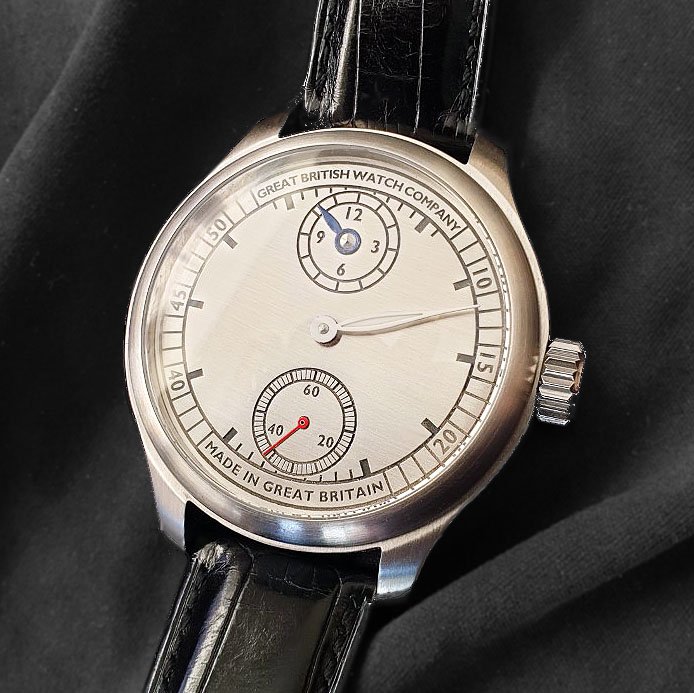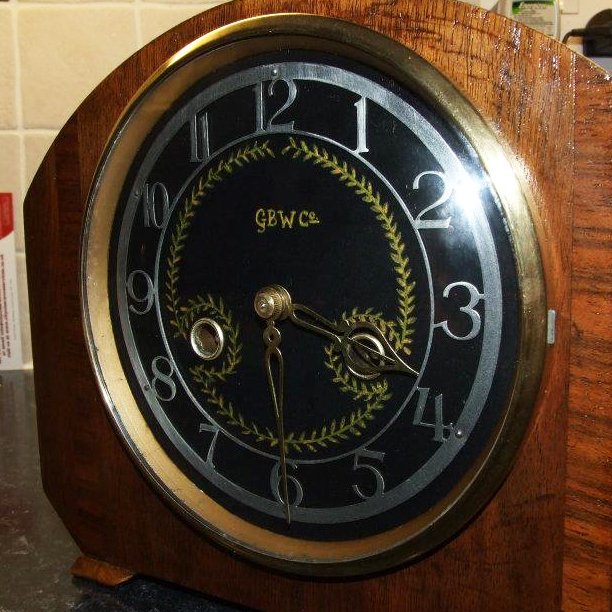On 20th December 2019 I started working full-time on my own watch business.
It is something that I’ve planned and dreamed of since I first started my training to become a watchmaker. My plan is to create a number of bespoke watches and I already have 5 commissions that I’m working on.
I would love to share the details of one of the projects in-particular, but it will have to remain a secret for the moment I’m afraid.
In the meantime I am taking on some additional commissions, as well as repair and refurbishment work. So please use the contact form if you would like to get in touch.
If you’re interested in having me make a watch for you then you’ll likely have to be quick before too much of a waiting list develops.
Logo and company name
One thing about my company that needed updating was the logo.

The original company logo
The printed company name is too much of a mouthful. The logo was something that I made in roughly 5 minutes back in 2011. The logo itself doesn’t scale well and does not look good on a dial. In fact that’s one of the reasons why when I made my own watch, I didn’t put the logo on there – just the company name.

I took a look at what all the other major watch houses are doing and could see a general consensus on how they laid out their logo and company name. This consensus would have been something that will have evolved over almost a century when watches first started to appear and so it is likely the best formula for a layout.

So I sketched out around 70 designs, and through that process I’ve refined the logo to be simpler and a more abstract version of the British union flag, it also now lends itself to being put on a crown or dial. It is based on Britannia’s shield.
The printed company name has been shortened to just GBW.
This really has come full circle, as in 2011 about a month after I’ve started to study horology I put my company name on my grandmother’s old clock that I had refurbished; and used GBW – albeit with a stylised “Co.” added.

Upskilling
I am currently learning hand engraving from a local expert. He has kindly agreed to pass on his skills which are becoming increasingly rare. This will allow me to make personal messages in the case, movement and dial; and once I am practiced enough I will be able engrave patterns and motifs too.
As part of my new range of watches I am having to manufacture some completely new parts including the case. To be able to do this accurately and consistently I need to make a 3D model of the parts first. I can then prototype these through 3D printing and test the function and form of the piece. So I am doing some self-study to become a lot more proficient in AutoCAD.
Fortunately the BHI’s training course has a module on technical drawing. So I was already quite well practised at using both AutoCAD and using pen and paper to make accurate drawings. I won the BHI’s prize for the best results worldwide in Technical Drawing when I took the exam; which was to draw a watch escapement in 3-4 hours.
I will also be learning to black polish from someone working at the UK’s best watchmaking workshop. Black polishing is a bit of a lost art, whereby you polish a surface – usually steel – so highly that is only reflects light at one angle. From all other angles the completely flat surface does not reflect light and so appears black. When light is reflected off the surface the reflection is so perfect that the steel appears white in colour. Only the very highest watches have this technique of polishing applied to them. It will take a skilled and experienced polisher 1-3 days to achieve this level of finishing; that’s per individual part, and so a whole watch with a black polish finish is 2-3 months of work.

These are three screws, two wheels and the click here that I made and gave a really high polish to. I didn’t get quite to the level of a black polish, however you can see the difference in how the light is reflected when compared with the other direct-from-manufacturer screws
Hopefully these skills will help me to add some really high-end and personal touches to the watches that I am making.
Horological Wine?
Very occasionally I enjoy a glass of wine. You can now buy a wine called “The Horologist”, and it’s really rather good. It’s Sauvignon Blanc from New Zealand, and I’ve found it very fruity and refreshing. In the UK it’s for sale in Morrisons supermarkets. Give it a try – just don’t expect it to make you a better watchmaker. Cheers!






David Pierce
1 March, 2020 at 10:12 pm
Colin,
I was a machinist for many years and developed and interest in mechanical watches later in life. I read numerous books not only repairing watches but also making watch parts. I also took into consideration the opinions of “experts” on watch forums. Their general opinion was if a watch part was not cut out with a jewelers saw and brought to its final shape with a file, then it was an incorrectly made part. I looked a little deeper into the issue and noticed that the major watch factories made watch parts in ways closer to my background. I was expecting to see large rooms full of watchmakers in green visor caps filing out watch parts but instead I saw wire EDM machines, CNC machining centers and CNC lathes. So what is BLACK POLISH and why is it a lost art?
As it turns out it is a fairly industry standard finish used in a multitude of applications from gauge blocks to faucet valves. In general industry it is called lapping but the result is the same. A surface is polished flat by hand or machine. Since polishing is a process of reducing the size of scratches in the material the scratches are polished to a size smaller than the length of a light ray. The scratches are still there but they can no longer be seen with visible light. At that point it is a mirror finish. The black polish is the result of the surface reaching a flatness of less than a light ray and light will only reflect in one direction. That is why it appears black when looked at from the side. The amount of flatness can be measured with a monochromatic light source and an optical flat.
david
Colin
1 March, 2020 at 10:52 pm
Hi David,
Thanks for your comment and providing further details.
The companies that use black polished steel in their watches; Roger Smith, Urban Jurgensen, Voutilainen to name a few, all do this level of lapping by hand. I’m sure a machine could be made to polish to that standard – the mirrors on telescopes are sure to be polished by machine for example – but for whatever reason a mechanical technique is not employed by watch manufacturers. What would be described as a mirror finish is a lot more common, which is generally a high-level of polish.
I am sure that one of the main reasons is how time consuming it is, and that the true value that comes from providing the finish is the understanding that a skilled hand has made it and the emotion that comes from that knowledge. I have seen thousands of watches with a high levels of finish produced by machines, and none of them compare to a part hand-polished by an expert; it is the difference between something that is 90% and 100% finished.
I have had the hand-lapping process explained to me beyond what I am already capable of polishing to, and it definitely is an art that takes years to properly master. Beyond the aesthetic qualities, it also has a practical purpose, as the smooth surface does not allow dust to settle on it as easily and it is more resistant to rust or oxidisation. I have examples of pocket watches over 200 years old that are still as perfectly polished as when they were first made, and this is due to the skilled lapping techniques that were used that have made the steel resistant to the elements over time.
I agree that you will often happen upon some misplaced snobbery – the watch industry as a whole can be very elitist. The truth is that machines should always be able to do something better than a human, particularly where accuracy and speed are needed. But a modern watch is an enigma, it is a long obsolete technology that is inferior in almost all ways to a digital watch; and yet it persists. Can a machine polish better than a human? I’m sure it can, but that seems to defeat the point – the imperfections add a human element and enhance the emotion for the wearer.
I am not sure that I would want a hand made part in an aeroplane I was flying in, but in a watch, for me and some others at least, is really does add that je ne sais quoi.
Colin
Pieter Dewever
2 March, 2020 at 1:02 pm
Dear Sir, I have been following your fascinating articles and updates for a long time. However, what keeps surprising me is that you do not mention the Gamages of London brand name (owned by Fields Luxury Ltd) anywhere. According to the Gamages website, this is a genuine British brand. Do you have an idea whether Gamages are actually produced in Great Britain or not? Many thanks for your response, Kind regards, Pieter
Colin
2 March, 2020 at 1:43 pm
Hi Pieter,
Thank you for your comment. I had not heard of Gamages of London before and so have taken a look at their website.
After looking at the watches that they have for sale, I can say with confidence that these are all 100% made in China. They will have asked a Chinese manufacturer to put their brand on a watch and have them complete all the work for them. The company and brand may well be British, but the watches unfortunately are not.
Colin
Pierre Dewever
2 March, 2020 at 2:01 pm
Thanks Colin for this clear answer. I participated in a Catawiki auction yesterday and “won” a Gamages watch for € 190. I was, unfortunately, misled by the claim on the Gamages website that the timepiece was entirely British-made and made by British technicians. Beste regards.
Bill Davis
2 March, 2020 at 2:54 pm
Hi Colin,
Love the new logo and what you are trying to do. I’ve followed your progress for years and am confident that your skill matched with your integrity will make your business a success.
Bill
Colin
3 March, 2020 at 10:37 am
Thank you Bill for your kind comment!
Julian
3 March, 2020 at 8:54 am
Best of luck with your new endeavors. I will keenly await future updates, regular I hope.
I’m not sure if your on instagram, but its a great way of sharing your progress with the worldwide watch community, as you are able to of course.
Colin
3 March, 2020 at 10:43 am
Thank you Julian,
I haven’t taken social media very seriously so far, but I know that will have to change. Once I get in the rhythm of my watch production there will hopefully be some really interesting updates to come!
Colin
Jack Ridout
3 March, 2020 at 1:24 pm
Colin, I’ve just sent my watch commission through. I can’t wait to get my finished watch! J
Colin
3 March, 2020 at 1:27 pm
Hi Jack,
Thanks a lot for your business. I look forward to working together to give you the watch you’ve always wanted.
Colin
Cláudio Vieira
16 March, 2020 at 8:42 am
Hello mr Colin
hope everything is going well, like you i love watches and please check this italian company ” Meccaniche Venexiane” start up company, i love the
Arsenale models
Best regards,
Cláudio Vieira
Colin
18 March, 2020 at 12:43 pm
Thanks Claudio
david pierce
16 March, 2020 at 7:31 pm
Are you planning to make every single part for your watches or certain parts? Setting up to manufacture everything in a watch is a daunting goal. It has only been in the last few years that Roland Murphy (RGM) began doing more of his operations in house. A GULLOCHE machine and a CNC machining center are a huge financial investment. Vianney Halter makes most of his parts in house. His shop is large and full of extremely expensive machines.
david
Colin
18 March, 2020 at 12:58 pm
Hi David,
Yes, making a watch does involve a lot of very expensive equipment. I am working with a number of different universities at the moment to produce my main watch collection, as they generally have the cutting edge of technology and plenty of expertise to help out. Getting my own CNC machine is something that will be a long way off, as they can be 7 figures for one with low enough tolerances.
To begin with I will be making the case, dial, hands and crowns all myself; with some basic modification of a Swiss movement (ETA). Making a movement in Britain would be fantastic, but it’s unrealistic at the moment and so I’ll make sure I work towards the what is achievable first.
Colin